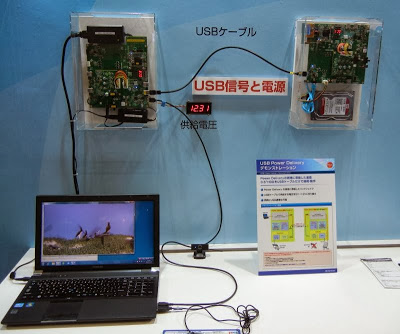Renesas Electronics Corp demonstrated the “USB Power Delivery Specification (USB PD),” which enables to provide up to 100W of electricity to a device while transmitting data via USB, at Embedded Technology 2013, which took place from Nov 20 to 22, 2013, in Yokohama, Japan.
With USB 3.0 specifications, it is possible to supply up to 5V of power at 900mA while transmitting data. On the other hand, the USB PD enables to provide up to 20V of power at 5A. In the demonstration, Renesas supplied 12V of power to a 3.5-inch HDD to play a movie file stored in the HDD.
USB Power delivery will provide smart direct current power up to 100 watts.
The USB PD defines five “profiles”, depending on the power to be supplied (10, 18, 36, 60 and 100W). It deals with voltages of 5, 12 and 20V and currents of 1.5, 2, 3 and 5A. Before supplying power via USB PD, a negotiation between power transmitting and receiving devices takes place to decide on a voltage and current.
Renesas is developing a chip incorporating a USB PD controller and analog front-end (AFE) that perform such preprocessing or “handshake,” aiming to release samples within the first half of fiscal 2014. The size of the chip will range from 4 x 4mm to 5 x 5mm, the company said. In the demonstration, it realized a USB PD controller and AFE by using an FPGA and discrete parts.
Renesas aims to provide “USB PD solutions” using the chip and its USB 3.0 transceiver IC to its customers in cooperation with companies that are well-versed in power-supply circuits and AC adapters.
Among the five profiles, Renesas is considering commercializing the 18W or 36W profile first, it said. For example, the company expects to use a USB PD-compatible AC adapter to supply 12V (3A) of power to a small notebook computer or 5V (3A) of power to a tablet computer.
If you liked this article, please give it a quick review on ycombinator or StumbleUpon. Thanks

Brian Wang is a Futurist Thought Leader and a popular Science blogger with 1 million readers per month. His blog Nextbigfuture.com is ranked #1 Science News Blog. It covers many disruptive technology and trends including Space, Robotics, Artificial Intelligence, Medicine, Anti-aging Biotechnology, and Nanotechnology.
Known for identifying cutting edge technologies, he is currently a Co-Founder of a startup and fundraiser for high potential early-stage companies. He is the Head of Research for Allocations for deep technology investments and an Angel Investor at Space Angels.
A frequent speaker at corporations, he has been a TEDx speaker, a Singularity University speaker and guest at numerous interviews for radio and podcasts. He is open to public speaking and advising engagements.


